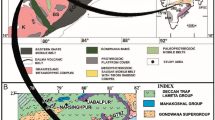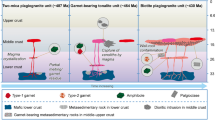Summary
The chemistry, structural parameters, polytypism, optical properties and Rb-Sr isotopes were examined in 11 to 60 samples of biotite, muscovite and lepidolite from the pegmatites at Rožná (the type locality of lepidolite; 323 ± 4Ma) and Dobrá Voda (306 ± 9Ma) in western Moravia. At both localities, early endocontact biotite is followed inwards by muscovite and lepidolite, which is concentrated in and around the core. At Rožná, a 1M lepidolite follows after 2M1 muscovite but all later generations of lepidolite are 2M2, close to Tri50 Ply50 and in part associated with muscovite 2M1. At Dobrá Voda, all lepidolite types are 1M and free of muscovite, and the late varieties approximate Tri30 Ply70. At both localities, a trend of increasing μHF is indicated during the progress of mica crystallization, culminating in precipitation of topaz. Polytypism of lepidolite is not correlatable with any compositional or growth feature, or their combination. Throughout the mica crystallization, Rb/Cs decreases but K/Rb becomes reversed after an initial decrease. Boron is partitioned preferentially into muscovite (up to 1.10 wt.% B2O3) but Be, Zn, Mn and Sc are enhanced in lepidolite. A slight increase in Fe, Ba and Cl in the last generation of lepidolite might be possibly due to mixing of residual pegmatite fluids with metamorphic pore solutions.
Zusammenfassung
In 11 bis 60 Proben von Biotit, Muskovit und Lepidolith aus den Pegmatiten von Rožná (Typlokalität des Lepidoliths; 323 ± 9 Ma) in Westmähren wurden Chemie, Struktur-parameter, Polytypie, optische Eigenschaften und Rb-Sr-Isotopie untersucht. An beiden Lokalitäten wird früher Biotit an Endokontakten nach Innen von Muskovit und Lepidolith gefolgt, letzterer ist in und um den Kern konzentriert. In Rožná folgt 1M-Lepidolith auf 2M1-Muskovit, aber alle späteren Lepidolithgenerationen sind 2M2, nahe Tri50Ply50 und zum Teil mit 2M1-Muskovit vergesellschaftet. In Dobrá Voda sind alle Lepidolithe vom Typ 1M und frei von Muskovit, die späten Varietäten kommen Tri50Ply50 nahe. An beiden Lokalitäten ist während des Fortschreitens der Glimmerkristallisation eine Tendenz von steigendem μHF angezeigt, die in der Ausfällung von Topas ihren Höhepunkt findet. Die Polytypie des Lepidoliths kann nicht mit irgendeiner Eigenheit der Zusammensetzung oder des Wachstums korreliert worden, auch nicht mit einer Kombination von diesen. Während der ganzen Glimmerkristallisation nimmt Rb/Cs ab, aber die Tendenz von K/Rb ändert sich nach anfänglichem Abfall. Das Bor verteilt sich bevorzugt auf den Muskovit (bis zu 1.10 Gew. -% B2O3), aber die Be-, Zn-, Mn- und Sc-Gehalte sind im Lepidolith erhöht. Ein leichter Ansteig von Fe, Ba und Cl in der letzten Lepidolithgeneration könnte vielleicht durch eine Mischung von pegmatitischen Restlösungen mit metamorphen Porenlösungen verursacht sein.
Similar content being viewed by others
References
Bailey SW (1984) Appendix 2: X-ray identification of mica polytypes. 1984 M. S. A. Short Course on Micas, 10 pp
Baronnet A (1975) L'aspect croissance du polymorphisme et du polytypisme dans les micas synthétiques d'intérèt pétrologique. Fortschr Mineral 52: 203–216
Berggren T (1941) Minerals of the Varuträsk pegmatite XXV; Some new analyses of lithium-bearing mica minerals. Geol Fören Förh 63: 262–278
Burkart E (1953) Mähren's Minerale und ihre Literatur. Czechosl Acad Sci, Praha
Burnham CW (1962) Lattice constant refinement. Carnegie Inst Wash Yearb 61: 132–135
Černý P (1982a) Mineralogy of rubidium and cesium. MAC Short Course Handb 8:149–162
Černý P (1982b) Petrogenesis of granitic pegmatites. MAC Short Course Handb 8: 405–461
Černý P, Burt DM (1984) Paragenesis, crystallochemical characteristics, and geochemical evolution of micas in granitic pegmatites. In:Bailey SW (ed) Micas Rev Mineral 13: 257–297
Chaplin CE (1981) Isotope geology of the Gloserheia granite pegmatite, South Norway. Thesis, University of Alberta, pp 109–110
Chaudhry MN, Howie RA (1973) Lithium-aluminum micas from the Meldon aplite, Devonshire, England. Mineral Mag 39: 289–296
Ercit TS (1986) The simpsonite paragenesis; the crystal chemistry and geochemistry of extreme Ta fractionation. Thesis, University of Manitoba, 468 pp (unpublished)
Ercit TS, Černý P, Hawthorne FC (1993) Cesstibtanite - a geologic introduction to the inverse pyrochlores. Mineral Petrol 48: 235–255
Foord EE, Martin RF, Fitzpatrick JJ, Taggart Jr JE, Crock JG (1991) Boromuscovite, anew member of the mica group, from the Little Three mine pegmatite, Ramona district, San Diego County, California. Am Mineral 76: 1998–2002
Foster MD (1960) Interpretation of the composition of lithium micas. US Geol Survey Prof Pap 354-E; 115–147
Franke W (1989) Tectonostratigraphic units in the Variscan belt of central Europe. Geol Soc Am Spec Pap 230: 67–90
Gordiyenko VV (1973) Cesium in lepidolite as indicator of the cesium content of granitic pegmatites. Doklady Acad Sci USSR 209: 193–196 (in Russian)
Gordiyenko VV, Ponomareva NI (1988) Physico-chemical stability conditions of lithian micas of the lepidolite series. Zapiski Vses Mineral Obsh 117: 633–638 (in Russian)
Gordiyenko VV, Semenova TF, Simakova YS (1991) Composition and polytypism of aluminolithian micas in granitic pegmatites. Mineral Zhur 13: 67–84 (in Russian)
Grew ES, Belakovskyi DI, Fleet ME, Yates MG, McGee JJ, Marquez N (1983) Reed-mergnerite and associated minerals from peralkaline pegmatite, Dara-i-Pioz, southern Tien Shan, Tajikistan. Eur J Mineral 5: 971–984
Hawthorne FC, Černý P (1982) The mica group. MAC Short Course Handb 8: 63–98
Heinrich EW (1967) Micas of the Brown Derby pegmatites, Gunnison County, Colorado. Am Mineral 52: 1110–1121
Jolliff BL, Papike JJ, Shearer CK (1987) Fractionation trends in mica and tourmaline as indicators of pegmatite internal evolution: Bob Ingersoll pegmatite, Black Hills, South Dakota. Geochim Cosmochim Acta 51: 519–534
Kantor J, Kupčo G (1956) On the absolute age of the Rožná lepidolite by the strontium method. Geol Práce GÚDŠ, Reports 7: 3–12 (in Slovak)
Klaproth MH (1792) Aus einem Schreiben von Hrn. Bergrath Karsten in Berlin. Bergmän-nisches Journal 1792, p 80
Köhler H, Propach G, Troll G (1989) Exkursion zur Geologie, Petrographie und Geochronologie des NE-bayerischen Grundgebirges. Eur J Mineral 1 (Spec Issue 2): 1–84
Kretz R (1983) Symbols for rock-forming minerals. Am Mineral 68: 277–279
Levinson AA (1953) Studies in the mica group; relationship between polymorphism and composition in the muscovite-lepidolite system. Am Mineral 38: 88–107
London D (1982) Stability of spodumene in acidic and saline fluorine-rich environments. Carnegie Inst Geophys Lab Ann Rep 81: 331–334
London D (1990) Internal differentiation of rare-element pegmatites; a synthesis of recent research. In:Stein HJ, Hannah JL (eds) Geol Soc America Spec Pap 246: 35–50
London D (1992) Application of experimental petrology to the genesis and crystallization of granitic pegmatites. Can Mineral 30: 499–540
Loucks RR (1991) The bound interlayer H2O content of potassic white micas: muscovite-hydromuscovite-hydropyrophyllite series. Am Mineral 76: 1563–1579
Munoz JL (1968) Physical properties of synthetic lepidolites. Am Mineral 53: 1490–1512
Munoz JL (1971) Hydrothermal stability relations of synthetic lepidolite. Am Mineral 56: 2069–2087
Němec D (1990) Chemical composition of white micas of the west-Moravian pegmatites. Acta Mus Moraviae, Sci Nat 75: 41–51
Novák M (1992) Rožná near Bystřice nad Pernštejnem. In: Field Trip Guidebook, Lepidolite 200 Symposium, Nové Město na Moravb 1992, pp 21–26
Novák M, Černý P, Čech F, Staněk J (1992) Granitic pegmatites in the territory of the Moravian and Bohemian Moldanubicum. In: Field Trip Guidebook, Lepidolite 200 Symposium, Nové Mésto na Moravb 1992, pp 11–20
Novotný M, Stelcl J (1951) Pegmatites from Hradisko and Borovina at Rožná. Acta Acad Sci Nat Moravo-Silesiacae 23, 12-F25: 259–274 (in Czech)
Ottolini L, Bottazzi P, Vannucci R (1993) Quantification of lithium, beryllium and boron in silicates by secondary ion mass spectrometry using conventional energy filtering. Analyt Chem 65: 1960–1968
Paul BJ (1984) Mineralogy and geochemistry of the Huron Clain pegmatite, southeastern Manitoba. Thesis, University of Manitoba, 364 pp (unpublished)
Pouchou JL, Pichoir F (1985) “PAP” (phi-rho-z) procedure for improved quantitative microanalysis. In:Armstrong JT (ed) Microbeam analysis. San Francisco Press, San Francisco, pp 104–106
Rancourt DG, Dang M-Z, Lalonde AE (1992) Mössbauer spectroscopy of tetrahedral Fe3+ in trioctahedral micas. Am Mineral 77: 34–43
Rinaldi R, Černý P, Ferguson RB (1972) The Tanco pegmatite at Bernie Lake, Manitoba. VI. Lithium-rubidium-cesium micas. Can Mineral 11: 690–707
Robert J-L, Volfinger M, Barrandon JN, Basutçu M (1983) Lithium in the interlayer space of synthetic trioctahedral micas. Chem Geol 40: 337–351
Ross M, Takeda H, Wones DR (1966) Mica polytypes: systematic description and identification. Science 151: 191–193
Sartori F (1976) The crystal structure of a 1M lepidolite. Tscher Mineral Petrol Mitt 23: 65–75
Sekanina J, Vysloužil J (1929) New reports on lepidolite from Rožná. Acta Soc Sci Nat Moravicae 5-2-1743: 25–32 (in Czech)
Shearer CK, Papike JJ (1986) Distribution of boron in the Tip Top pegmatite, Black Hills, South Dakota. Geology 14: 199–123
Staněk J (1965) The Dobrá Voda pegmatite near Velké Meziříčí. Folia Fac Sci Nat Univ Purkynianae 6–8: 1–39 (in Czech)
Stevens RE (1938) New analyses of lepidolites and their interpretation. Am Mineral 23: 607–628
Strunz H (1962) Bor and Beryllium in Phyllosilikaten. Rend See Mineral Ital 13: 372–376
Swanson TH, Bailey SW (1981) Redetermination of the lepidolite-2M1 structure. Clay and Clay Minerals 29: 81–90
Takeda H, Haga N, Sadanaga R (1971) Structural investigation of polymorphic transition between 2M2-, 1M - lepidolite and 2M1-muscovite. Mineral J Japan 6: 203–215
Teertstra DK, Černý P, Novák M (1995) Compositional and textural evolution of pollucite in pegmatites of the Moldanubicum. Mineral Petrol 55 (this volume)
Tröger WE (1962) Über Protolithionit und Zinnwaldit. Ein Beitrag zur Kenntnis von Chemismus und Optik der Lithiumglimmer. Beitr Mineral Petrog 8: 418–431
Vysloužil J (1929) Analytical contributions to the Moravian mineralogy and petrography. Bull 6th Conf Czechoslovak Sci Med Doc Engineers, Praha 1928, part III (in Czech)
Wilson GC, Long JVP (1983) The distribution of lithium in some Cornish minerals: ion microprobe measurements. Mineral Mag 47: 191–199
Yvon K, Jeitschko W, Parthé E (1977) LAZY PULVERIX, a computer program for calculating X-ray and neutron diffraction patterns. J Appl Cryst 10: 73–74
Author information
Authors and Affiliations
Additional information
With 9 Figures
Rights and permissions
About this article
Cite this article
Černý, P., Chapman, R., Staně, J. et al. Geochemical and structural evolution of micas in the Rožná and Dobrá Voda pegmatites, Czech Republic. Mineralogy and Petrology 55, 177–201 (1995). https://doi.org/10.1007/BF01162587
Received:
Accepted:
Issue Date:
DOI: https://doi.org/10.1007/BF01162587




